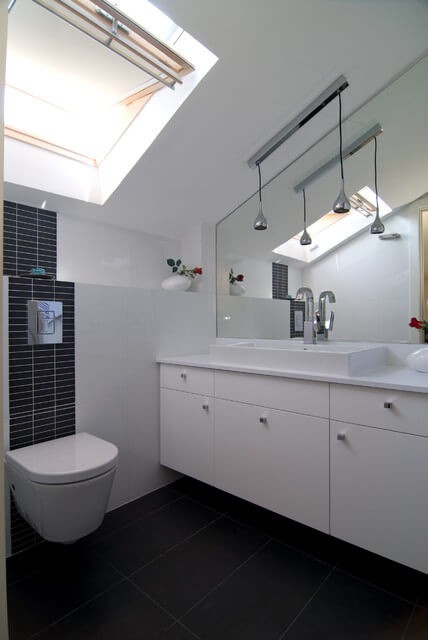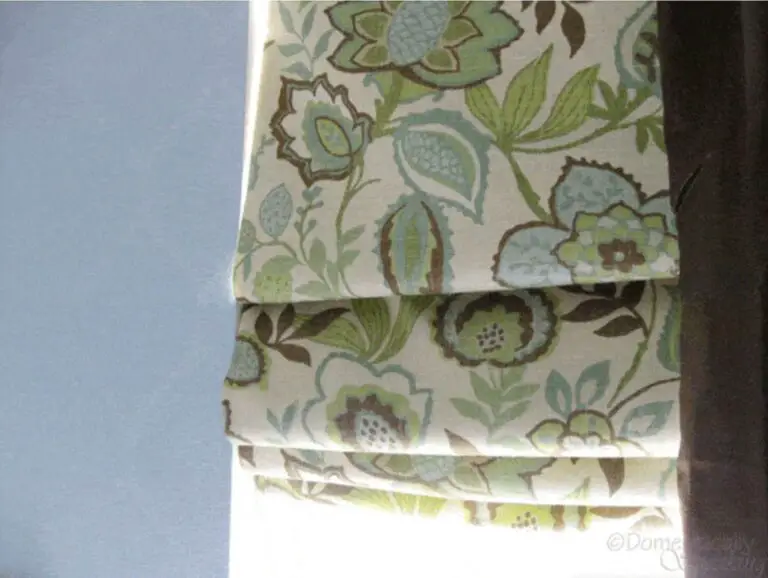14+ Best Bathroom Sink Ideas & Designs For Your Home
The bathroom sink is often the unsung hero of the bathroom. As the most used feature, its design can make or break the overall aesthetic. When renovating or redecorating, it’s crucial not to neglect this essential element. Every home deserves a unique and functional bathroom sink that caters to their needs. This article will explore various aspects of bathroom sinks, from unclogging and maintenance to creative designs and renovation ideas.
How Can You Unclog A Bathroom Sink?
The frustration of a clogged sink in the bathroom can be overwhelming, but fortunately, there are various straightforward techniques to address this issue. Instead of feeling helpless, you can rely on your resourcefulness to create effective solutions using household items, take matters into your own hands and plunge away, opt for specialized products designed for unclogging drains, or even try snaking your drains.
Furthermore, you can explore different methods and discover the most suitable approach for your specific situation by consulting reputable sources like WikiHow.
What is a Bathroom Sink Made Of?
When it comes to bathroom sinks, one thing is certain – they’re incredibly diverse. This diversity is reflected in the wide range of materials used to manufacture them, from classic porcelain and fireclay to modern plastic and even metals like cast iron, stainless steel, and copper. The variety of options available means that homeowners can choose a sink that not only fits their aesthetic but also meets their practical needs.
What Is The Standard Size Of A Bathroom Sink Drain?
Bathroom sink drains are available in a variety of sizes, with the most common being 1.25 inches in width. While 1.5 and 1.625 inch options are also relatively common, it’s essential to note that the size of your drainhole plays a crucial role in determining the type of bathroom sink you can install. To ensure a smooth installation process, make sure you know the width of your drainhole before selecting a new sink.
How High Is A Bathroom Sink?
When it comes to bathroom sink heights, there’s a noticeable range. Typically, sink heights fall between 29 and 36 inches, with variations depending on the type of sink installed. Pedestal sinks, for instance, tend to be slightly lower, measuring in at around 29-33 inches, while cabinet sinks are often slightly taller, ranging from 30 to 36 inches.
This variation highlights the importance of considering sink height when designing or renovating a bathroom to ensure optimal comfort and functionality.
Can I Paint My Bathroom Sink?
The fate of your sink depends on its material. While porcelain sinks require professional refinishing, stainless steel and acrylic sinks can be painted with caution. It’s crucial to heed the correct guidance to avoid causing irreparable harm to your bathroom.
25 Bathroom Sink Ideas
When it comes to selecting a bathroom sink, finding the perfect fit is crucial. It’s not just about aesthetics; the functionality and practicality of your sink also play a significant role in enhancing your overall bathroom experience. To help you make an informed decision, we’ve curated a comprehensive list of 20+ innovative and stylish bathroom sink ideas that cater to various tastes and needs.
Euro bronze accents and handmade encaustic tiles

Creative countertop & Raised basin sinks
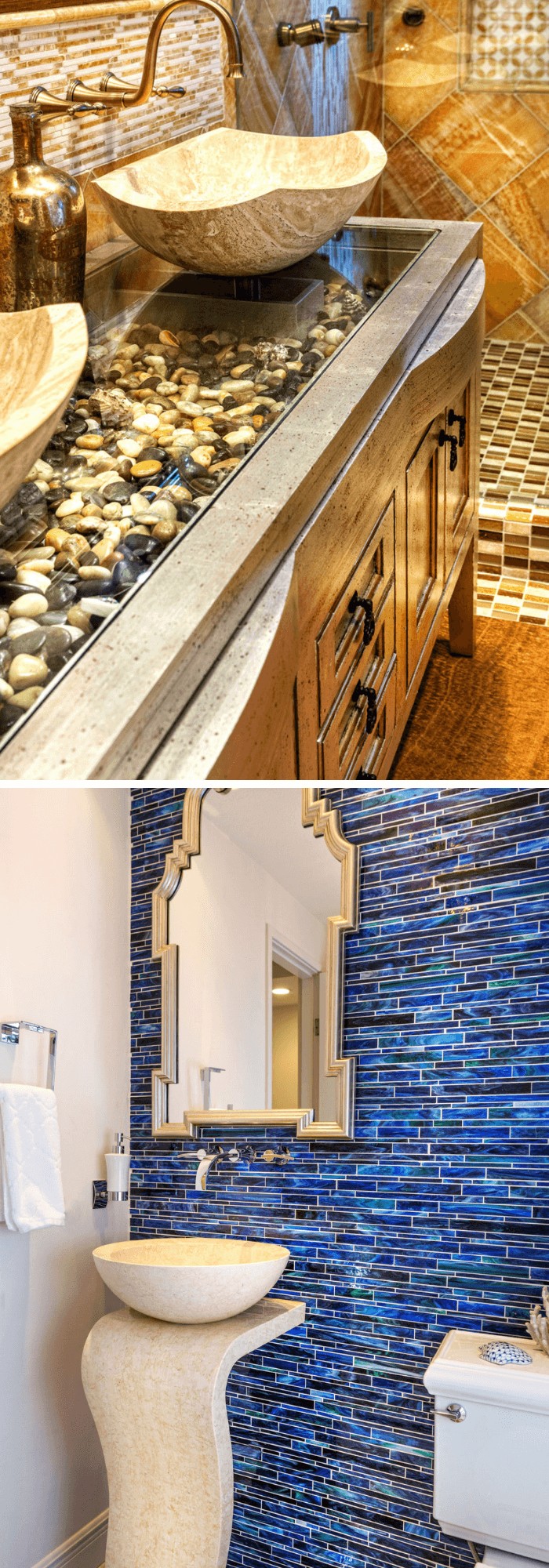
Standalone sink
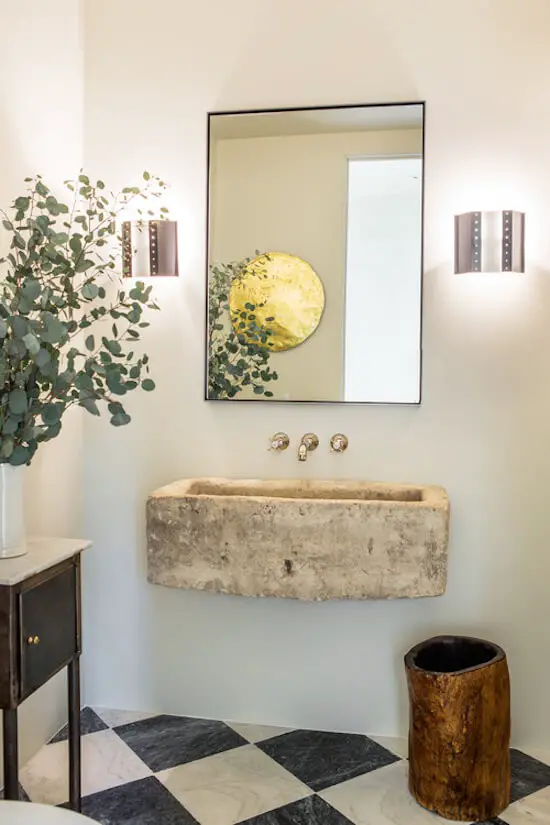
Raised corner sink
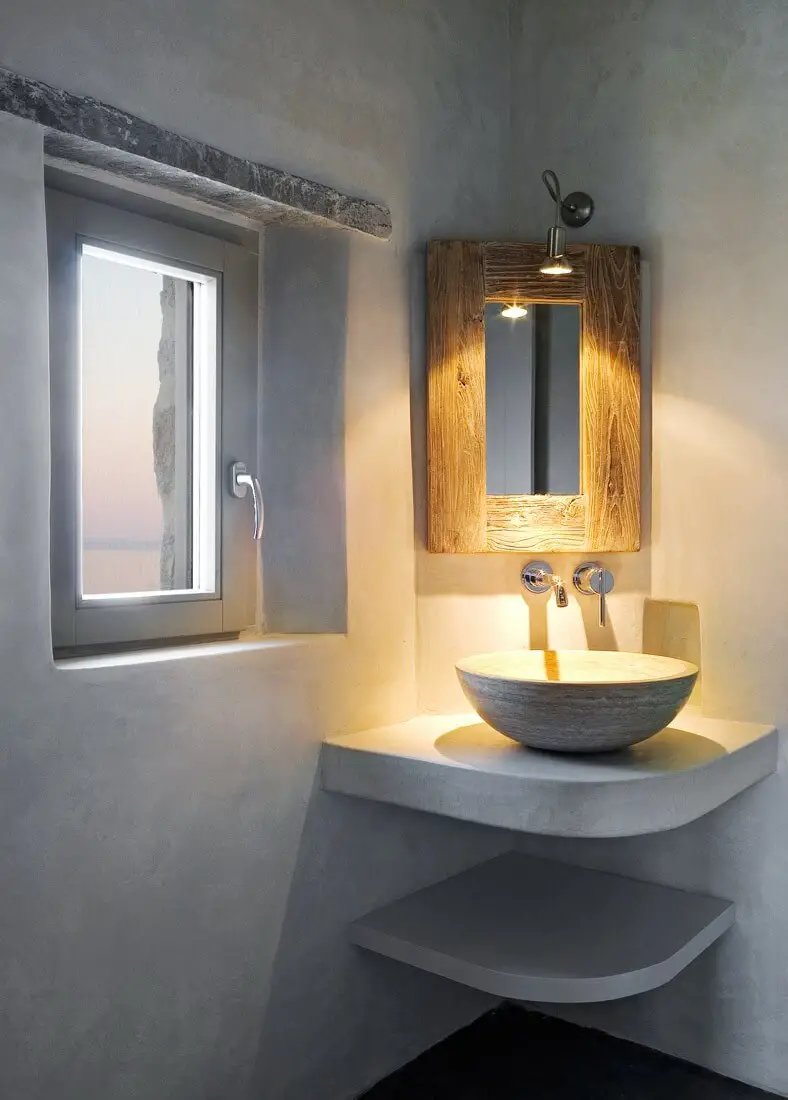
Rustic stone basin

Sink with pattern of fish and lotus blossom

DIY Floating Sink Shelf

Master bathroom makeover: large mirror

Natural stone sinks

Scary Bathroom Prank

Rustic square sink

Stone sinks

Colorful bathroom sinks

DIY Utility Sink Makeover

Recycle Rustic For Farmhouse Bathroom Sinks

Elevate the rustic charm of your bathroom with these sturdy galvanized tub buckets. Their impressive depth and durability make them a versatile solution for families of all sizes, providing ample storage space while adding a touch of authentic farmhouse flair to your bathroom’s aesthetic.
Make Your Sink An Above The Counter Bathroom Feature

Rather than concealing your sink beneath the countertop, consider upgrading to a sleek, glass rectangular vessel bathroom sink that effortlessly blends style with practicality. Not only does it simplify cleaning duties, but its modern aesthetic ensures it’ll remain a stunning focal point in any bathroom configuration.
Keep It Simple With An Undermount Bathroom Sink

Elevate the ambiance of your bathroom with an understated yet refined undermount sink. Boasting a minimalist aesthetic, these sinks seamlessly blend into any bathroom design. Whether you’re aiming for a sleek and modern or classic and timeless look, an undermount sink can be a fantastic addition to your space.
Surprise Your Guests With A Copper Bathroom Sink

Naturally occurring antimicrobial properties make copper sinks a popular choice for bathrooms. With their timeless allure, copper sinks can be found in a range of styles, from the simplicity of plain designs to more ornate, intricately crafted pieces. Consider opting for a hammered copper or an elegantly designed copper bathroom sink to add a touch of sophistication and functionality to your space.
Get Artistic With A Melted Summer Leaf Bowl
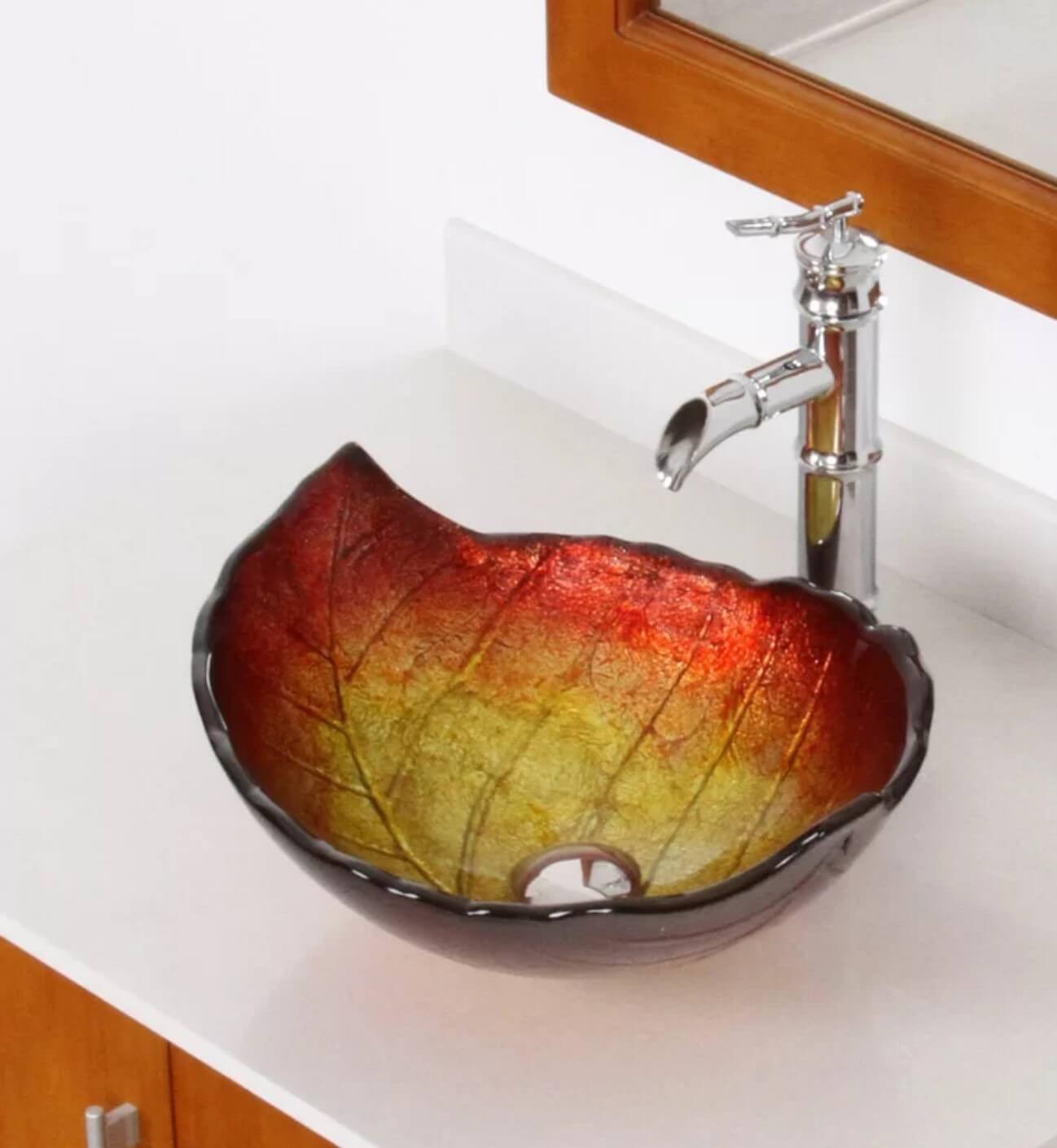
The allure of the melted summer leaf-shaped bathroom sink bowl lies in its perfect balance between boldness and subtlety. It’s an unexpected design that transforms the mundane space into an area where you’ll actually want to linger, admiring its unique contours from the tub. Why settle for a standard sink when you can have one that becomes a focal point of your bathroom?
Banish Boring With A Floral Patterned Bowl Sink

Elevate your bathroom experience by transforming your sink into a lush oasis with unique floral patterns. Don’t limit yourself to traditional designs; instead, let your creativity flourish and bring the outdoors in.
Make A Statement With A Crystal Bathroom Sink

What catches your attention when it comes to a bathroom sink is often the visual appeal, and this crystal bathroom sink truly stands out. Its sleek design and radiant appearance make it a showstopper in any bathroom, adding an air of sophistication and elegance.
Stand Tall With A Freestanding Sink

When designing your dream bathroom, it’s easy to get caught up in thinking about the focal points like countertops and shower enclosures. However, don’t overlook the often-overlooked freestanding sinks and vessels. By incorporating these elements into your design, you can create a sense of cohesion and style that ties the entire space together. This subtle yet effective detail can make all the difference in achieving a look that’s uniquely yours.
Admire The Nobel Copper Bathroom Sink

The combination of an oxidized copper exterior with copper handles and interior creates a striking visual effect that is beautifully complemented by the presence of wood. This unique fusion of materials can be elevated further by placing the sink atop the counter, effectively turning it into a show-stopping focal point in the bathroom.
Keep It Classic With A Modern Pedestal Sink
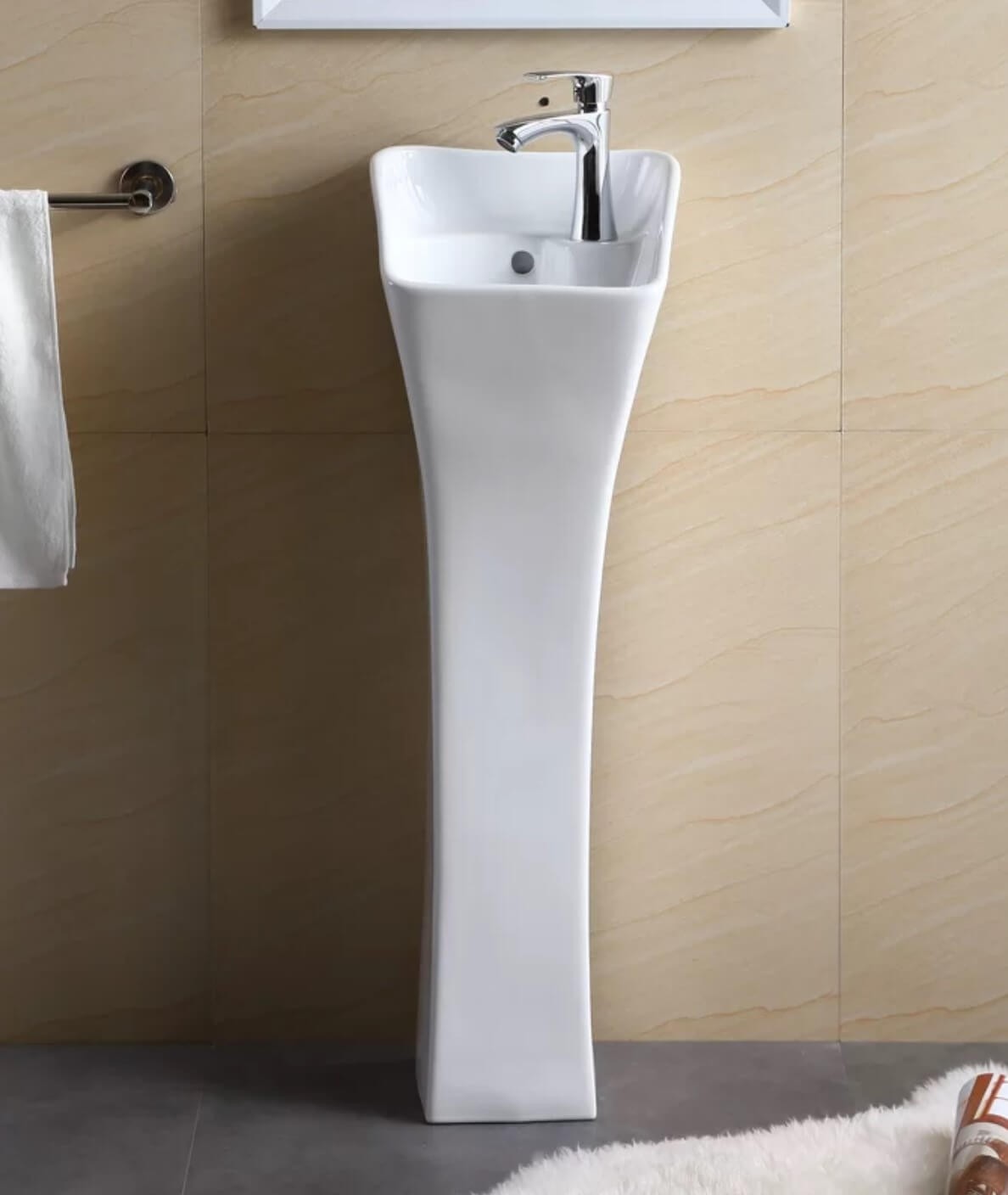
With its flute-like silhouette, this Chinese-inspired pedestal bathroom sink seamlessly blends modern flair with timeless elegance. Standing tall and proud, it reiterates the enduring appeal of freestanding sinks, defying the notion that they’ve lost their allure.
How to Caulk the Bathroom Sink
Caulking a bathroom sink is often overlooked as a simple task, but it’s crucial to ensure the longevity and safety of your bathroom. The key to success lies in preventing moisture from seeping into the floor, cabinet, or woodwork. Water and mold can wreak havoc on your bathroom, causing costly repairs and even posing health hazards. According to experts, mold growth can be a significant threat to those who frequent the bathroom, and removing it entirely can cost thousands of dollars.
On the other hand, preventing moisture from entering your bathroom is a relatively inexpensive task that requires only a few hours of effort. By taking the time to properly caulk your bathroom sink, you can avoid costly repairs in the future. To get started, you’ll need caulking, which comes in tube form or cartridges for use with a caulking gun.
For single-bathroom homeowners, the tube is likely the more cost-effective option, while those with multiple bathrooms may find the gun and cartridge more practical. Prices range from $4 to $15, depending on your choice. Before applying new caulk, it’s essential to remove any existing adhesive completely. This process can be tedious, as caulking is designed to stick. Use a razor blade, screwdriver, or knife to scrape away every last bit of old caulk, taking extra care if you discover mold.
After removal, thoroughly clean the area with a stronger cleanser than soap. Once the surface is dry, you’re ready to apply new caulk. Some important tips to keep in mind include not attempting to repair partial caulking and instead removing it entirely for a fresh start. It’s also essential to invest in high-quality bathroom-specific caulking, which may cost slightly more but performs better.
Unclogging a Bathroom Sink
Clogged sinks can be a real nuisance, but we often neglect them until it’s too late. As long as the water is flowing freely, we don’t tend to worry about what’s being flushed down the drain – until all these elements combine to cause a blockage in our bathroom sink. The simplest solution to try first is the trusty plunger. Make sure you have one on hand, as it can be a lifesaver in many plumbing emergencies.
Fill the sink with a bit of water and plunge away, repeating the process at least a dozen times. Check if the water flow has improved after each attempt. Don’t give up until you’ve exhausted all options – and remember to cover the overflow drain to build up pressure on the clog. If it works, follow up by running hot water through the sink for several minutes to dislodge any remaining debris. If the plunger doesn’t do the trick, it’s time to move on to more advanced solutions.
The next step is to take apart the tailpiece, also known as the P-trap. You may need a pipe wrench or similar tool for this task, which can be unpleasant due to the strong odors involved. However, if the clog is located in the tailpiece, you should be able to clean it out and reassemble it without further issue. If none of these methods work, it’s time to bring in the big guns – or rather, the caustic chemicals specifically designed for unclogging sinks.
These products can be found on the market or made at home using ingredients like vinegar, alcohol, or gasoline. Just be sure not to overdo it, as excessive use can harm the environment and your pipes. As a last resort, consider renting or purchasing a drain snake – also known as an auger. This tool is designed to reach deep into your plumbing system and break up stubborn blockages. The smallest models are around 30 feet long and can be manipulated to partially control their direction.
As you work the snake through the pipes, you may feel it breaking down the clog or encounter resistance that signals its presence. Remember to always wear gloves when working with chemicals or drain snakes for your safety. Once you’ve successfully unclogged your sink, don’t forget to run hot water through the drain for several minutes to ensure everything is flowing smoothly again.
Unclogging a Bathroom Sink Drain
When dealing with a clogged bathroom sink, it’s not necessary to break the bank to get it unclogged. While calling a plumber can be a quick and effective solution, there are also simple DIY methods you can try first. Most clogs in bathroom sinks are caused by hair, soap, toothpaste, and other substances that have accumulated over time.
If some water is still flowing through the drain, your problem may not be too severe.
Partially clogged drains are often the easiest to clear, as there’s still a path for water to flow through.
One of the simplest ways to attempt unclogging is to pour boiling water down the drain. This can help dissolve and break up any greasy substances that may be contributing to the clog.
If boiling water doesn’t do the trick, you can try a more aggressive approach using vinegar and baking soda. Mix equal parts of each and pour the mixture down the drain.
Let it sit for at least 30-45 minutes before flushing with hot water. This combination is effective against many types of clogging elements in bathroom sinks.
In some cases, you may need to add a bit of physical force to help dislodge the clog. A plunger can be used on top of the vinegar and soda mixture to apply pressure and suction. This pulling and pushing motion can help create movement in the pipe and help clear the blockage.
For more stubborn clogs, you may need to get a bit more creative. If nothing else works, you might need to remove the pipe and clean it out by hand or with some specialized tools. In rare cases, you may even need to use a steel cable to push through any debris that’s causing the blockage.
In most cases, however, you should be able to clear your bathroom sink drain using one of these methods.
Just remember to try and address any clogs before they become too severe – partially clogged drains are often much easier to fix than completely blocked ones.
Replacing a Bathroom Sink Faucet
Replacing the bathroom sink faucet is a DIY-friendly project that requires minimal tools and expertise. This straightforward process can be completed in no time, making it an ideal solution for those looking to save money or speed up their home renovation plans. To avoid any potential mishaps, it’s crucial to turn off the main water supply before commencing the replacement process. Failing to do so can result in a sudden gush of water, causing chaos and damage.
Once the water is shut off, allow the pipes to drain completely. This will ensure a safe working environment and prevent any accidents. With the old faucet removed, it’s essential to thoroughly clean the area, removing any residual caulk, mold, or debris. A thorough cleaning process will not only guarantee a smooth installation but also safeguard your health. To install the new faucet, simply follow the inverse of the removal process.
Most faucets come equipped with all necessary components, except for caulk. In some cases, you may receive a rubber gasket, eliminating the need for additional sealing materials. When applying caulk, opt for an anti-mold variant specifically designed for bathrooms. Tighten all bolts and screws firmly, but avoid applying excessive pressure. Finally, turn on the water supply and perform a leak test to ensure a seamless installation.
With these straightforward steps, you’ll be able to replace your bathroom sink faucet with ease, saving time and money in the process.
Related Posts
When it comes to bathroom remodeling, incorporating walk-in tubs is a crucial feature that prioritizes safety and accessibility. For seniors, this feature can be particularly beneficial in creating an inclusive living space. Some of the key features that make walk-in tubs safe for the elderly include slip-resistant surfaces, grab bars, and adjustable seating.
Additionally, considering trends like luxury and functionality, homeowners may also want to explore alternative coverings for bathroom walls instead of traditional tiles. To become a kitchen and bath designer, one must first understand the career pathway involved, including necessary skills and training. Alternatively, when it comes to finding the right bath pillow, there are several factors to consider, such as material, size, and comfort level.
Overall, prioritizing safety and accessibility is essential in creating a harmonious bathroom space that meets the needs of all users.




